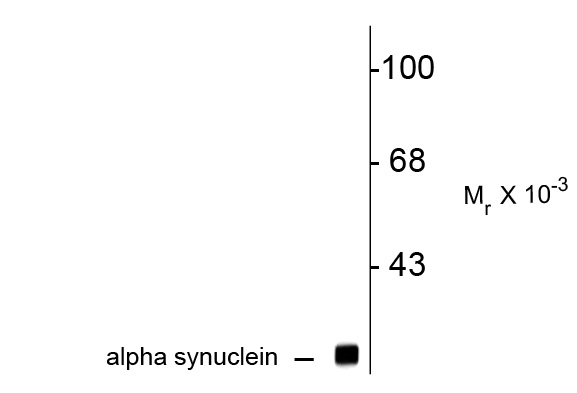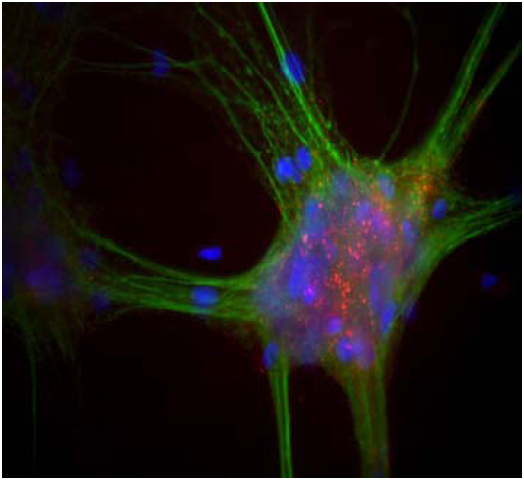alpha Synuclein Antibody
Mouse monoclonal antibody
- SPECIFICATION
- CITATIONS
- PROTOCOLS
- BACKGROUND

Application
| WB, IF |
|---|---|
| Primary Accession | P37840 |
| Reactivity | Human, Mouse, Rat |
| Host | Mouse |
| Clonality | monoclonal |
| Isotype | IgG1 |
| Clone Names | 3H9 |
| Calculated MW | 15 KDa |
| Gene ID | 6622 |
|---|---|
| Gene Name | SNCA |
| Other Names | Alpha-synuclein, Non-A beta component of AD amyloid, Non-A4 component of amyloid precursor, NACP, SNCA, NACP, PARK1 |
| Target/Specificity | Full length human alpha synuclein expressed in E. Coli. |
| Dilution | WB~~1:1000 IF~~1:500 |
| Format | Mouse ascites fluid. |
| Antibody Specificity | Specific for the ~15kDa alpha Synuclein protein. |
| Storage | Maintain refrigerated at 2-8°C for up to 6 months. For long term storage store at -20°C in small aliquots to prevent freeze-thaw cycles. |
| Precautions | alpha Synuclein Antibody is for research use only and not for use in diagnostic or therapeutic procedures. |
| Shipping | Blue Ice |

Thousands of laboratories across the world have published research that depended on the performance of antibodies from Abcepta to advance their research. Check out links to articles that cite our products in major peer-reviewed journals, organized by research category.
info@abcepta.com, and receive a free "I Love Antibodies" mug.
Provided below are standard protocols that you may find useful for product applications.
Background
Alpha-synuclein is a presynaptic neuronal protein that is thought to be involved in the formation of SNARE complexes. Most significantly, aggregated alpha-synuclein is one of the major components found in the Lewy bodies that occur in Parkinson’s disease (PD) and other neurodegenerative disorders (Okochi et al., 2000). Early onset Parkinson's disease may be caused by a duplication or triplication of one of the alpha synuclein genes (Chartier-Harlin MC et al., 2004 and Singleton, AB et al., 2005). Alpha-synuclein is also found in the Lewy bodies of patients with diffuse Lewy body disease and inclusions in glial cells in the brains of patients with multiple system atrophy (MSA) and amyotrophic lateral sclerosis (ALS).
References
Okochi M, Walter J, Koyama A, Nakajo S, Baba M, Iwatsubo T, Meijer L, Kahle PJ, Haass C (2000) Constitutive phosphorylation of the Parkinson’s disease associated alpha-synuclein. J Biol Chem Jan 7;275(1): 390-7.
Chartier-Harlin, MC. et al. Alpha-synuclein locus duplication as a cause of familial Parkinson's disease. Lancet 364: 1167-1169 (2004).
Singleton, AB et al. Alpha-synuclein locus triplication causes Parkinson's disease. Science 302: 841 (2003).
If you have used an Abcepta product and would like to share how it has performed, please click on the "Submit Review" button and provide the requested information. Our staff will examine and post your review and contact you if needed.
If you have any additional inquiries please email technical services at tech@abcepta.com.













 Foundational characteristics of cancer include proliferation, angiogenesis, migration, evasion of apoptosis, and cellular immortality. Find key markers for these cellular processes and antibodies to detect them.
Foundational characteristics of cancer include proliferation, angiogenesis, migration, evasion of apoptosis, and cellular immortality. Find key markers for these cellular processes and antibodies to detect them. The SUMOplot™ Analysis Program predicts and scores sumoylation sites in your protein. SUMOylation is a post-translational modification involved in various cellular processes, such as nuclear-cytosolic transport, transcriptional regulation, apoptosis, protein stability, response to stress, and progression through the cell cycle.
The SUMOplot™ Analysis Program predicts and scores sumoylation sites in your protein. SUMOylation is a post-translational modification involved in various cellular processes, such as nuclear-cytosolic transport, transcriptional regulation, apoptosis, protein stability, response to stress, and progression through the cell cycle. The Autophagy Receptor Motif Plotter predicts and scores autophagy receptor binding sites in your protein. Identifying proteins connected to this pathway is critical to understanding the role of autophagy in physiological as well as pathological processes such as development, differentiation, neurodegenerative diseases, stress, infection, and cancer.
The Autophagy Receptor Motif Plotter predicts and scores autophagy receptor binding sites in your protein. Identifying proteins connected to this pathway is critical to understanding the role of autophagy in physiological as well as pathological processes such as development, differentiation, neurodegenerative diseases, stress, infection, and cancer.



